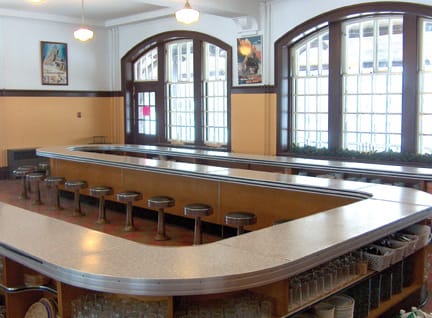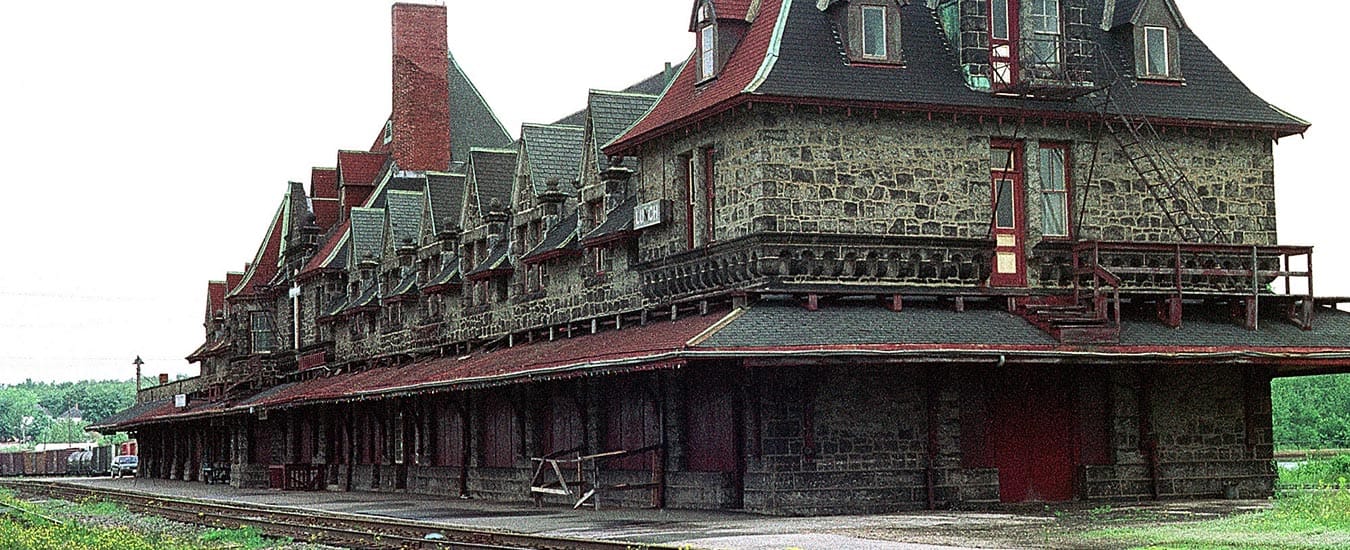A majestic, 108-year-old train station off the beaten track is now a destination in itself.
CONNIE SAMPSON was passing through rural New Brunswick last fall when she decided to stop at the McAdam Railway Station. The last passenger train had left town in 1994, but Sampson, of Prince Albert, Sask, found a door open, and was welcomed in by a local resident.
She headed up the stairs to check out the 17 "hotel" rooms on the second floor. In May 1904 her grandmother gave birth to her father in one of these rooms en route home to Montreal, and Sampson wanted a photo as a keepsake.

"I thought about how my grandmother must have felt, exiting the train in labour, knowing the baby was coming…waiting for the midwife," she said-her grandmother giving new meaning to the "arrivals" aspect of a train station.
Sampson was also captivated by the building itself. Located approximately 170 kilometres west of Saint John, the McAdam train station is an example of Canadian Pacific Railway's chateau style of architecture at the turn of the last century, typical of the majestic stations and hotels along routes across the country. With its granite walls, steeply pitched roof, gabled dormers, arches and spires, the station is reminiscent of larger CP landmarks, such as the Chateau Frontenac in Quebec City or the Banff Springs Hotel in Alberta.
"It is just a marvellously gorgeous building," said Sampson, who during her visit had also snapped pictures of the pond behind the station, which provided water for steam locomotives.
Sampson was not alone in visiting McAdam last year-roughly 10,000 people stopped by the station, a promising number given the fact that 14 years ago it was falling apart, and a candidate for demolition. But thanks to local efforts it's now being refurbished. A few years back its profile even graced a postage stamp.
The station gets all kinds of visitors-from those with personal ties to the building, like Sampson, to hard-core railroad buffs interested in anything displaying the initials RR; retired railway men who once worked there and unsuspecting travellers, surprised to see the majestic 108-year-old building.
"We like to show it now that we are getting some things done," says Frank Campbell, the volunteer who happened to be in the station when Connie Sampson stopped by. He's one of several dozen townspeople who have spent a good chunk of the past decade strategizing and raising money-and painting and hammering-for the sake of the station, as well as their community.
 McAdam was once a bustling railway town like few others. During the golden era of steam engines, up until the late 1950s, virtually every train on its way to the Maritimes from Western Canada or the US would stop in town for servicing. Sixteen passenger trains and up to a dozen freight trains would lumber in daily; hundreds of passengers disembarked to grab a bite to eat or spend the night. There were two roundhouses, carpenter and blacksmith shops, coal bins and water towers. As a child growing up in the town, Campbell remembers the flurry of activity in the railyards and the excitement of each train's arrival.
McAdam was once a bustling railway town like few others. During the golden era of steam engines, up until the late 1950s, virtually every train on its way to the Maritimes from Western Canada or the US would stop in town for servicing. Sixteen passenger trains and up to a dozen freight trains would lumber in daily; hundreds of passengers disembarked to grab a bite to eat or spend the night. There were two roundhouses, carpenter and blacksmith shops, coal bins and water towers. As a child growing up in the town, Campbell remembers the flurry of activity in the railyards and the excitement of each train's arrival.
But then the diesel engine replaced the steam locomotive; cars and planes became a preferred means of travel. In 1994 the station was boarded up and pretty much left to varmints and vandals.
Enter a dedicated group of locals who formed the McAdam Historical Restoration Committee. Through a combination of private funds and government and corporate grants, the group raised $300,000-and immediately set out to fix the leaky roof.
"The ceiling was gone; floors were rotting," Campbell says. The station was so decrepit that many in the community wanted to bulldoze it into the pond. But the preservationists prevailed. Several rooms have been refurbished, including the main lobby, the telegraph office, the dining room and the lunch room, which seats 65 people on stools at a W-shaped Arborite counter-and where travellers would have coffee and "railroad pie."
"We are doing it bit by bit," explains Campbell, referring to the work as well as the fundraising. To date $1 million has been raised, but the Restoration Committee has a long-term goal of $10 million. It sometimes does come in bits-like the cash donation pressed into Campbell's hand as Sampson left-but also in major infusions, such as $480,000 expected from the federal government.
Campbell shows some of the station's interior features such as the tiny jail cell, where rowdies were held overnight; the third-floor dormitory, ceiling plaster still dropping, where female station employees lived (males lived on the other side of the building); the single ladies' waiting room, where a display of memorabilia includes old tickets, spittoons, headlights from steam engines and conductors' uniforms.
Although McAdam used to be a principal junction for travellers it's now off the beaten track, and Campbell doubts the station will ever become a major destination resort. Still, he expects more people will come as improvements continue. Already the station opens for events such as family reunions, weddings and birthday parties-if not emergency births. Once the hotel rooms are restored, the site might offer bed and breakfast services.
"The station has to be developed in concert with the strengths of our community, and basically our strength is the wilderness," he says. Just as the station's hotel rooms once offered rest and relaxation for long-distance train travellers, so it might now offer rest and relaxation for the thousands of hunters and other outdoor adventurers who visit the area's woods and wild rivers-before they head home in their cars.
